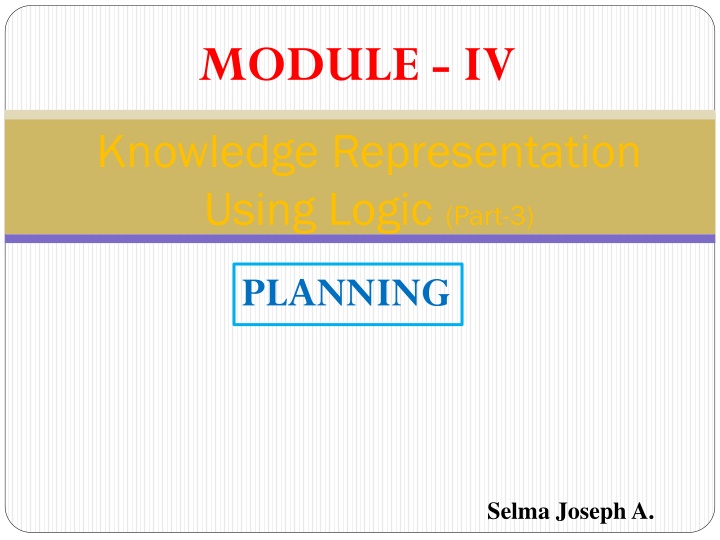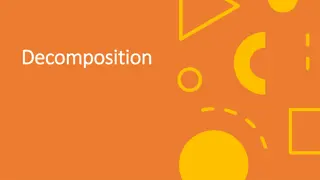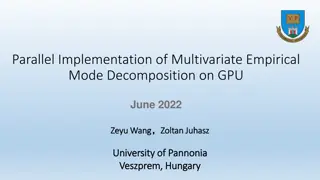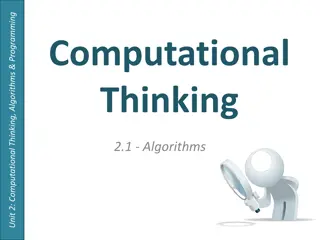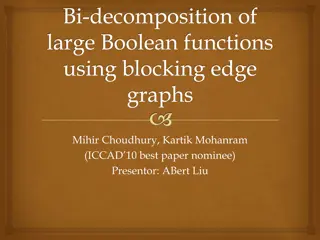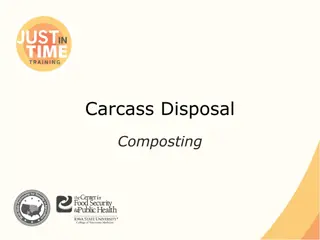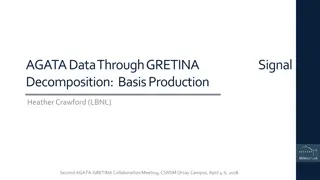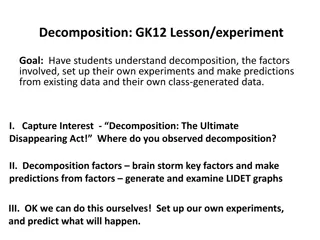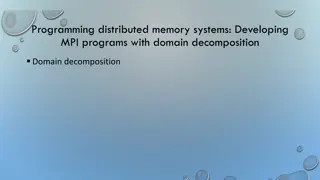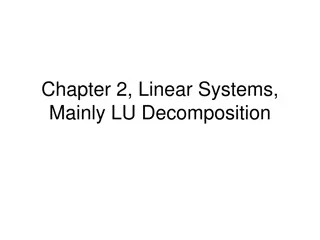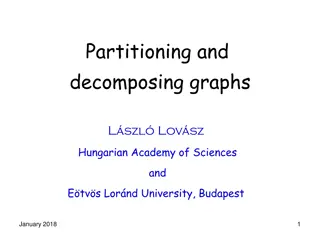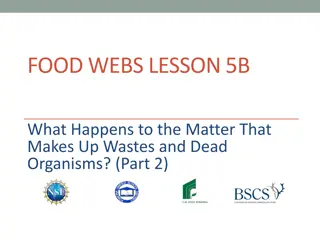Planning Process and Problem Decomposition
Planning is a crucial aspect of achieving desired results by decomposing complex problems into smaller sub-parts. Learn about problem decomposition, nearly decomposable problems, impact of predictability on planning, and components of a planning system. Understand how to choose rules, apply them, detect solutions, identify dead ends, and repair incorrect solutions in the planning process.
Download Presentation

Please find below an Image/Link to download the presentation.
The content on the website is provided AS IS for your information and personal use only. It may not be sold, licensed, or shared on other websites without obtaining consent from the author.If you encounter any issues during the download, it is possible that the publisher has removed the file from their server.
You are allowed to download the files provided on this website for personal or commercial use, subject to the condition that they are used lawfully. All files are the property of their respective owners.
The content on the website is provided AS IS for your information and personal use only. It may not be sold, licensed, or shared on other websites without obtaining consent from the author.
E N D
Presentation Transcript
MODULE - IV Knowledge Representation Using Logic (Part-3) PLANNING Selma Joseph A.
Overview Planning is a fundamental property of intelligent behavior. It is the first and foremost activity to achieve desired results. Decomposition of problems When trying to solve a complicated problem, it may be necessary to work on small pieces of the problem separately and then combine the partial solutions at the end into a complete problem solution. Decomposition is important because The decomposition may help us to avoid recomputing the entire problem state when we move from one state to next. The decomposition may divide a single difficult problem into several easier sub-problems. 1. 2. Selma Joseph. MCA LMCST 2
Overview Nearly decomposable problems It may not be always possible to divide a problem into completely separate sub-problems. However, problems may be nearly decomposable by which we mean that they can be divided into sub- problems that have only a small amount of interaction. Planning Planning is the process of decomposing a problem into appropriate subparts and of recording and handling interactions among the subparts as they are detected during the problem solving process. The word planning also refers to the process of computing several steps of a problem solving procedure before executing them Selma Joseph. MCA LMCST 3
Overview Impact of predictability on planning The success of the planning approach depends critically on the predictability of the problem s domain or universe. If the universe is unpredictable we cannot be sure of the outcome of a solution step. In such cases we can consider only a set of possible outcomes possibly in some order according to the likelihood of the outcome occurring. Possibly the plan have to include paths for all possible outcomes of each step. But there may have many outcomes for each step. In such situations it would be a great waste of effort to formulate plans for all possibilities. If the universe is unpredictable, we may take one step at a time and not really try to plan ahead. Or, we may try to produce a plan that is likely to succeed. If the plan fails, we may start the planning process over again! Selma Joseph. MCA LMCST 4
Components of a planning system The following are the components of a planning system: 1. Choosing rules to apply 2. Applying rules 3. Detecting a solution 4. Detecting dead ends 5. Repairing an almost correct solution Selma Joseph. MCA LMCST 5
Components of a planning system Choosing rules to apply The commonly used technique can be described as: 1. Isolate a set of differences between the desired goal state and the current state. 2. Identify those rules that reduce the differences. 3. If several rules are found, use heuristic methods to choose one. Applying rules In simple systems, application of rules is easy. Each rule simply specified the problem state that would result from the application of the rule. In complex systems rules specify only a small part of the problem state. In such cases there are several methods for the application of rules. 1. Describe each of the changes to the state description of the rule makes. Add a new rule that everything else is remaining unchanged. To do this, we may require the explicit statements of a large number of premises or axioms. 2. Describe each operator by a list of new predicates (called ADD) that the operator causes to become true and a list of old predicates (called DELETE) that the operator causes to become false. There is also a third list (called PRECONDITION) which specifies the predicates that must be true for the operator to be applied. Any predicate not Selma Joseph. MCA LMCST included in either ADD or DELETE is assumed to be unaffected by the rule 6
Components of a planning system Detecting a solution A planning system can be considered to have succeeded in finding a solution to a problem. In simple problems the system can easily determine whether it has succeeded in finding a solution by checking whether the problem state and goal state match. But in complex problems, in a description of a problem state, the entire state may not be explicitly described. So in such cases there should be a method to determine whether two problem states match. This method will depend on how the various states are represented in the planning system. For example, suppose that a planning system is represented using predicate logic. Let there be a predicate P(x) as part of the goal. To see whether P(x) has been satisfied at any stage, it is enough to prove that we can derive P(x) from the assertions describing that particular state. If we can construct such a proof, the problem-solving process can be ended. Detecting dead-ends The planning system must be able to detect dead-end, that is, it must be able to determine whether a path it is exploring can never lead to a solution. The mechanisms for detecting a solution are used to detect dead-ends also. Selma Joseph. MCA LMCST 7
Components of a planning system Repairing an almost correct solution Consider the problem of solving a nearly decomposable problem. We assume that the problem is completely decomposable and solve each sub-problem separately and then combine the solutions of the sub-problems to obtain a solution of the original problem. Since the problem is only nearly decomposable, the combined solution may not be the correct solution; it will only be an almost correct solution. The following are some of the ways in which an almost correct solution may be repaired. 1. Throw out the almost correct solution and look for another. 2. Consider the situation arising from the execution of the sequence of operations specified in the proposed almost correct solution. The difference between this and the goal will much less than the difference between the initial state and the goal. The problem solving system may be applied again to eliminate the difference. 3. Find exactly what went wrong and try a direct patch. 4. Apply the least commitment strategy. This means, leave the almost correct solutions incompletely specified until the last possible moment and when as much information as possible is available complete the specifications in such a way that no conflicts arise. Selma Joseph. MCA LMCST 8
Goal stack planning Stacks As the name indicates, in goal stack planning, we make use the stack data structure. A stack is an Abstract Data Type (ADT). It is named stack as it behaves like a real-world stack like a stack of books or a pile of plates, etc. A real-world stack allows operations at one end only. For example, we can place or remove a book or a plate from the top of the stack only. Likewise, the Stack ADT allows all data operations at one end only. At any given time, we can only access the top element of a stack. Selma Joseph. MCA LMCST 9
Goal stack planning Goal stack In goal stack planning, we make use of stack called a goal stack usually denoted by GS. The goal stack GS contains both subgoals and actions that have been proposed to satisfy those subgoals. It relies on a database, denoted by DB, that describes the current situation, and a set of actions described by PRECONDITION, ADD and DELETE lists. Basic idea At each succeeding step of the problem solving process, a subgoal of the stack is pursued. An action that could cause it to be true is sought. If an appropriate action is found, its precondition is established as the top subgoal of the stack in order for that action to be applicable. When a sequence of actions that satisfies a subgoal is found, that sequence is applied to the current situation, yielding a new current situation. Then, all the subgoals that are satisfied by the new current situation are popped off the stack. Next, another subgoal of the stack is explored . This process continues until the goal stack is empty. Then, as one last check, the original goal is compared to the final situation derived from the application of the chosen actions. If any conditions on the goal are not satisfied in that situation, then those unsolved subgoals are reinserted onto the stack and the process resumed. Selma Joseph. MCA LMCST 10
Goal stack planning The STRIPS planner The reasoning strategy used by STRIPS is goal stack planning. STRIPS (Stanford Institute Problem Solver) is an automated planner developed by Richard Fikes and Nils Nilsson in 1971. The same name was later used to refer to the formal language of the inputs to this planner. This language is the base for most of the languages for expressing planning problem instances in use today; such languages are commonly known as action languages. Algorithm 1. Push the compound predicate describing the goal state in to the Stack. 2. Push the individual predicates of the goal state in to the Stack. 3. Loop till the Stack is empty (a) Pop an element E from the Stack. (b) If E is a predicate i. If E is True A. Do nothing. ii. Else A. Push the relevant action into the Stack. B. Push the individual predicates of the precondition of the action into the stack. (c) Else if E is an action a i. Apply the action a to the current state. ii. Add the action a to the plan. Research automated Selma Joseph. MCA LMCST 11
Goal stack planning Illustration: Blocks world To illustrate the goal stack planning approach, we consider the blocks world domain. 1. The objects of the blocks world o A flat surface on which blocks can be placed. o A number of square blocks, all of the same size. o A robot arm that can manipulate the blocks. o Blocks can be stacked one upon another. 2. Predicates and relations to describe the state of the blocks world Predicate Meaning o ON(x, y) Block x is on block y o ONTABLE(x) Block x is on table. o CLEAR(x) There is nothing on top of block x o HOLDING(x) The arm is holding block x o ARMEMPTY The arm is holding nothing. Selma Joseph. MCA LMCST 12
Goal stack planning 3. Actions The following are the available actions in the blocks world. Action o UNSTACK(x,y) Pick up block x from its current position on block y and hold it in the arm o STACK(x,y) Place block x held in the arm on block y. o PICKUP(x) Pick up block x from table and hold it. o PUTDOWN(x) Put block x held in the arm down on the table. Meaning Selma Joseph. MCA LMCST 13
Goal stack planning The PRECONDITION list (the list of predicates that should be true to apply the action), ADD list (the list of predicates that become true after the action) and DELETE list (the list of predicates that become false after the action) associated with the various actions are given below.. Action PRECONDITION list ADD list DELETE list UNSTACK(x,y) ARMEMPTY, CLEAR(x), ON(x. y) HOLDING(x), CLEAR(y) HOLDING(x), CLEAR(y) ARMEMPTY, ON(x,y), CLEAR(x) HOLDING(x) ARMEMPTY STACK(x, y) PICKUP(x) ARMEMPTY, CLEAR(x). HOLDING(x). ARMEMPTY PUTDOWN(x) ARMEMPTY, ONTABLE(x), CLEAR(x) Selma Joseph. MCA LMCST 14
Goal stack planning 4. Problem Given the initial and the final states of a blocks world with four blocks as shown in Figure use goal stack planning algorithm to obtain a plan for achieving the goal state. Fig: A simple blocks world problem: Initial state on the left and the goal state on the right 5. Solution Step 1. The initial state can be described by the statement: ON(B,A)^ONTABLE(A)^ONTABLE(C)^ONTABLE(D)^ARMEMPTY The goal state can be specified by the statement: ON(C,A) ^ ON(B,D) ^ ONTABLE(A) ^ ONTABLE(D) Selma Joseph. MCA LMCST 15
Step 2. We create a stack and call it GS. We initialize GS to be empty. (empty) ________________________________________ Step 3. We push the goal state to the stack: ON(C,A) ^ ON(B,D) ^ ONTABLE(A) ^ ONTABLE(D) Step 4. The goal state can be divided into four components, namely, ON(C,A) , ON(B,D) , ONTABLE(A) , and ONTABLE(D) Of these the last two are true in the initial state. We push the first two components to the stack GS. ON(C,A) ON(B,D) ON(C,A) ^ ON(B,D) ^ ONTABLE(A) ^ ONTABLE(D) Selma Joseph. MCA LMCST 16
Step 5. Consider the top item in GS which is ON(C,A). Check whether it is true in current state. It is not. Find an action which makes it true. the action is STACK(C,A).We replace ON(C,A) by STACK(C,A) to get the following GS. STACK(C,A) ON(B,D) ON(C,A) ^ ON(B,D) ^ ONTABLE(A) ^ ONTABLE(D) Step 6. To apply the action STACK(C,A) the preconditions CLEAR(A)^HOLDING(C) must be true. This precondition and also its components are also pushed to the stack GS. CLEAR(A) HOLDING(C) CLEAR(A) ^ HOLDING(C) STACK(C,A) ON(B,D) ON(C,A) ^ ON(B,D) ^ ONTABLE(A) ^ ONTABLE(D) Selma Joseph. MCA LMCST 17
Step 8. To apply UNSTACK(B,A), the precondition ON(B,A)^CLEAR(B)^ARMEMPTY must be true. We add this precondition and its components to the stack GS. Step 7. We now check whether CLEAR(A) is true. It is not. The only operator that make it true is UNSTACK(B,A). So we replace CLEAR(A) by UNSTACK(B,A). UNSTACK(B,A) HOLDING(C) CLEAR(A) ^ HOLDING(C) STACK(C,A) ON(B,D) ON(C,A) ^ ON(B,D) ^ ONTABLE(A) ^ ONTABLE(D) ON(B,A) CLEAR(B) ARMEMPTY ON(B,A) ^ CLEAR(B) ^ ARMEMPTY UNSTACK(B,A) HOLDING(C) CLEAR(A) ^ HOLDING(C) STACK(C,A) ON(B,D) ON(C,A) ^ ON(B,D) ^ ONTABLE(A) ^ ONTABLE(D) Selma Joseph. MCA LMCST 18
Step 9. The top element ON(B,A) is true and so we pop it off from the stack. The next element CLEAR(B) is also true and so we pop it off also. At the current state, the arm is not holding anything and so ARMEMPTY is also true and we pop it off also. Sine each of the components of the next statement is true, the compounded statement is also true. Thus it is also popped off from the stack GS. At this stage the stack is as follows. UNSTACK(B;A) HOLDING(C) CLEAR(A) ^ HOLDING(C) STACK(C,A) ON(B,D) ON(C,A) ^ ON(B,D) ^ ONTABLE(A) ^ ONTABLE(D) Selma Joseph. MCA LMCST 19
Step 10. The top element of the stack is UNSTACK(B,A). The preconditions for applying this action are satisfied. (a) We now apply this operator to get a new world state. (b) We record that UNSTACK(B,A) is the first operator of the solution sequence. (c) The state of the world is specified by the following statements: ONTABLE(A),ONTABLE(C),ONTABLE(D); HOLDING(B),CLEAR(A) (d) The goal stack GS is now HOLDING(C) CLEAR(A) ^ HOLDING(C) STACK(C,A) ON(B,D) ON(C,A) ^ ON(B,D) ^ ONTABLE(A) ^ ONTABLE(D) Step 11. The process is now repeated. Selma Joseph. MCA LMCST 20
Hierarchical planning Hierarchical planning The basic approach In order to solve real world problems, the problem solver may have to generate long plans. To do this efficiently, the problem solver may ignore some of the details of the problem until a solution to the main issues have been found. This can be done by creating a hierarchy of the tasks to be performed and then attempting to find a solution starting from the tasks at the highest level of the hierarchy. Creating a plan in this way is known as hierarchical planning. Example For example, let it be required to travel at short notice to Mumbai with minimum expenses for an interview. The task of the highest priority is to check the availability of an airline at affordable cost. After finding a plan to solve this problem, the person may find plans for solving the next level problems like preparing baggage and hiring a taxi. Attempts to solve these problems lead to problems at the third level: detailed plans for preparing the baggage and hiring a taxi. These will in turn lead to problems at the next lower level. Selma Joseph. MCA LMCST 21
The ABSTRIPS planner system The ABSTRIPS planner system ABSTRIPS, a planning system developed in 1974 and built on top of the STRIPS planning system, is a planning system has a method for the implementation of hierarchical planning. In ABSTRIPS, the hierarchies are constructed by assigning criticalities which are numbers indicating relative difficulty to the preconditions of the operator. First a plan is found that satisfies only the preconditions of the operators of the highest criticality values. The plan is then refined by considering the preconditions at the next level of criticality and inserting steps into the plan to achieve these preconditions. The process is repeated to the lowest level of criticality. For this system to work, there must be a scheme to assign the appropriate criticality values to the various terms in the precondition. Because this process explores entire plans at one level of detail before looking any of the lower details, it has been called length-first search. Selma Joseph. MCA LMCST 22
